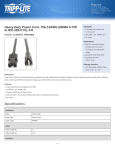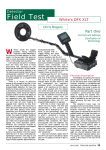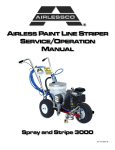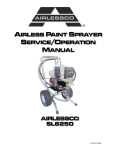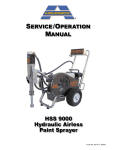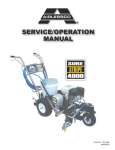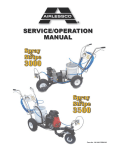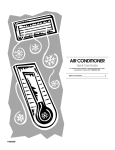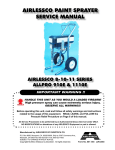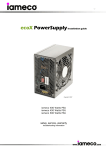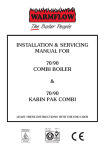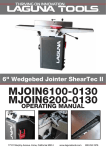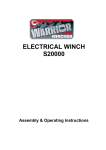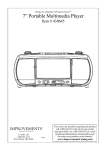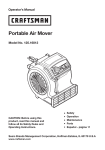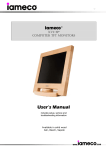Download QP019 Manual
Transcript
Q-TECH Q-P019 ELECTRIC AIRLESS SPRAY PUMP USER MANUAL CAUTION! This manual contains important warnings and information PLEASE READ & KEEP FOR FUTURE REFERENCE ISSUE DATE 31.05.2014 2 User Manual Q-Tech Q-P019 - Electric Airless Spray Pump SPECIFICATIONS Model Motor Type Power input Voltage Max Tip Size Max Flow Max Pressure Dimensions (LxWxH) Net Weight Q-P019 Universal 700W 110-120V~ 50-60Hz , 220-240V~ 50-60Hz 0.021” 1.9 l/min (0.42 gpm) 207 bar (3,000 psi) 36 x 25 x 40 cm 11.4 kg Material Applications Wood interior Ceiling Wood exterior Lacquer, Varnish, Stain, Sealer, Enamel, High-build, Exterior stain, Vinyl, Acrylic, Latex Carry Handle Pressure Adjustor Knob Brush Cap Fuse Packing Nut On/Off Switch Outlet Fitting Suction Hose Inlet Strainer Drain Tube Priming Valve www.aristospray.com GENERAL SAFETY RULES WARNING! Read and understand all instructions. Failure to follow all instructions listed below may result in electric shock, fire and / or serious personal injury. The term airless sprayer in all of the warnings listed below refers to your mains-operated (corded) airless sprayer. b) SAVE THESE INSTRUCTIONS c) Work area d) a) Keep your work area clean and well lit. Cluttered benches and dark areas invite accidents. b) Do not operate airless sprayers in explosive atmospheres, such as in the presence of flammable liquid, gases, or dust. Airless sprayers create sparks which may ignite the dust or fumes. c) Keep bystanders, children, and visitors away while operating a airless sprayer. Distractions can cause you to lose control. e) properly grounded. If the sprayer should electrically malfunction or break down, grounding provides a low resistance path to carry electricity away from the user. Avoid body contact with grounded surfaces such as pipes, radiators, ranges and refrigerators. There is an increased risk of electric shock if your body is earthed or grounded. Do not expose airless sprayers to rain or wet conditions. Water entering an airless sprayer will increase the risk of electric shock. Do not abuse the cord. Never use the cord for carrying, pulling or unplugging the airless sprayer. Keep the cord away from heat, oil, sharp edges or moving parts. Replace damaged cords immediately. Damaged or entangled cords increase the risk of electric shock. When operating an airless sprayer outdoors, use an outdoor extension cord suitable for outdoor use. Use of a cord suitable for outdoor use reduces the risk of electric shock. Personal Safety Electrical Safety a) Airless sprayer plugs must match the outlet. Never modify the plug in any way. Do not use any adapter plugs with earthed (grounded) airless sprayers. Unmodified plugs and matching outlets will reduce the risk of electric shock. Grounded sprayers must be plugged into an outlet properly installed and grounded in accordance with all codes and ordinances. Never remove the grounding prong or modify the plug in any way. Do not use any adaptor plugs. Check with a qualified electrician if you are in doubt as to whether the outlet is a) Stay alert, watch what you are doing and use common sense when operating an airless sprayer. Do not use while you are tired or under the influence of drugs, alcohol, or medication. A moment of inattention while operating airless sprayers may result in serious personal injury. b) Use safety equipment. Always wear eye protection. Safety equipment such as dust mask, non-skid safety shoes, hard hat, or hearing protection used for appropriate conditions will reduce personal injuries. c) Avoid accidental starting. Ensure the switch is in the off position before plugging in. 3 4 User Manual Q-Tech Q-P019 - Electric Airless Spray Pump d) Do not overreach. Keep a proper footing and balance at all times. This enables better control of the airless sprayer in unexpected situations. e) Dress properly. Do not wear loose clothing or jewellery. Keep your hair, clothing and gloves away from moving parts. Loose clothes, jewellery or long hair can be caught in moving parts. Service Have your airless sprayer serviced by a qualified repair person using only identical replacement parts. This will ensure that the safety of the airless sprayer is maintained. If the supply cord of this airless sprayer is damaged it must be replaced by a specially prepared cord available through the service organization. SPECIFIC SAFETY RULES HANDLE THIS UNIT AS YOU WOULD A LOADED WEAPON! Extreme high pressure spray can cause extremely serious injury. OBSERVE ALL WARNINGS! WARNING: HIGH PRESSURE. Never leave pressurized system unattended. Always follow the Pressure Relief Procedure. Take precautions to avoid high pressure component rupture. DANGER: INJECTION INJURY. Skin injection by high pressure paint is not a simple cut. It must be treated surgically immediately. WARNING: FIRE AND EXPLOSION HAZARD. Take all precautions to avoid sources of sparks and ignition when spraying. Keep the machine at least 6 meters away from the spraying operation. WEAR PROTECTIVE EQUIPMENT AT ALL TIMES. Always use a respirator, eye protection and protective clothing. Keep clear of moving parts when starting or operating the sprayer. Do not put your fingers into any openings to avoid amputation by moving parts or burns on hot parts. When starting the motor, maintain a safe distance from moving parts of the equipment. Before adjusting or servicing any mechanical part of the sprayer, follow the PRESSURE RELIEF PROCEDURE. EXPLOSION RISK FROM HALOGENATED HYDROCARBON SOLVENTS Never use halogenated hydrocarbon solvents in this machine. Contact with aluminum parts may cause an explosion. Some of the most common of these solvents are: Carbontetrachloride Chlorobenzene Dichloroethane Dichloroethyl Ether Ethylbromide Ethylchloride Tethrachloethane www.aristospray.com PREVENT STATIC SPARKING FIRE/EXPLOSIONS Vapors created when spraying can be ignited by sparks. To reduce the risk of fire, always locate the sprayer at least 20 feet (6 m.) away from spray area. Do not plug in or unplug any electrical cords in the spray area. Doing so can cause sparks which can ignite any vapors still in the air. Follow the coating & solvent manufacturers safety warnings and precautions. MEDICAL ALERT - Airless Spray Injection Injuries If any fluid appears to penetrate your skin, GET EMERGENCY MEDICAL CARE AT ONCE. DO NOT TREAT AS AN ORDINARY CUT. High pressure fluids from spray or leaks are powerful enough to easily penetrate the skin and cause extremely serious injection injury, leading to the possible need for amputation. • NEVER point the spray gun at anyone or any part of the body. • NEVER put your hand or fingers over the spray tip. Do not use a rag or any other materials over your fingers. Paint will penetrate through these materials and into the hand. • NEVER try to stop or deflect leaks with your hand or body. • ALWAYS have the tip guard in place when spraying. • • • • • • • • • • • • • ALWAYS lock the gun trigger when you stop spraying. ALWAYS remove tip from the gun to clean it. NEVER try to "blow back" paint, this is not an air powered sprayer. ALWAYS follow the PRESSURE RELIEF PROCEDURE before cleaning or removing the spray tip or servicing any system equipment. Be sure the equipment safety devices are operating properly before each use. Tighten all of the fluid connections before each use. NEVER alter equipment in any manner. NEVER smoke while in spraying area. NEVER spray highly flammable materials. NEVER use around children. NEVER allow another person to use sprayer unless he is thoroughly instructed on its safe use and given this operator’s manual to read. ALWAYS wear a spray mask, gloves and protective eye wear while spraying. ALWAYS ensure fire extinguishing equipment is readily available and properly maintained. NEVER LEAVE SPRAYER UNATTENDED WITH PRESSURE IN THE SYSTEM. FOLLOW PRESSURE RELIEF PROCEDURES ALWAYS INSPECT SPRAYING AREA • • • Keep the spraying area free from obstructions. Make sure the spraying area has good ventilation to safely remove vapors and mists. NEVER keep flammable material in spraying area. 5 6 User Manual Q-Tech Q-P019 - Electric Airless Spray Pump • • NEVER spray in vicinity of open flame or other sources of ignition. The spraying area must be at least 20 ft. away from spray unit. TOXIC FLUID HAZARD • SPRAY GUN SAFETY • • • • • ALWAYS set gun safety lock in the "LOCKED" position when not in use & before servicing or cleaning. NEVER remove or modify any part of the gun. ALWAYS REMOVE THE SPRAY TIP when cleaning. Flush unit at the LOWEST POSSIBLE PRESSURE. ALWAYS check operation of all gun safety devices before each use. Be very careful when removing the spray tip or hose from the gun. A plugged line will contain fluid under pressure. If the tip or line is plugged, follow the pressure relief procedure TIP GUARD • ALWAYS have the tip guard in place on the spray gun while spraying. The tip guard alerts you to the injection hazard and helps prevent accidentally placing your fingers or any part of your body close to the spray tip. • • HOSES • • SPRAY TIP SAFETY • • Use extreme caution when cleaning or changing spray tips. If the spray tip clogs while spraying, engage the gun safety latch immediately. ALWAYS follow the PRESSURE RELIEF PROCEDURE and then remove the spray tip to clean it. NEVER wipe off build up around the spray tip. ALWAYS remove tip guard & tip to clean AFTER pump is turned off and the pressure is relieved by following the PRESSURE RELIEF PROCEDURE. Hazardous fluid or toxic fumes can cause serious injury or death if splashed in eyes or on skin, inhaled or swallowed. Know the hazards of the fluid you are using. Store & dispose of hazardous fluid according to manufacturer, local, state & national guidelines. ALWAYS wear protective eyewear, gloves, clothing and respirator as recommended by fluid manufacturer. • Tighten all of the fluid connections securely before each use. High pressure fluid can dislodge a loose coupling or allow high pressure spray to be emitted from the coupling and result in an injection injury or serious bodily injury. Only use hoses with a spring guard. The spring guard helps protect the hose from kinks or other damage which could result in hose rupture and cause an injection injury. Do not allow kinking or crushing of hoses or allow it to vibrate against rough, sharp or hot surfaces. Use only conductive fluid hoses for airless applications. Be sure the gun is grounded through the hose connections. Use only high pressure airless hoses with static wire which are approved for 3000 psi. www.aristospray.com • • NEVER use a damaged hose, which can result in hose failure or rupture and cause an injection injury or other serious bodily injury or property damage. Before each use, check entire hose for cuts, leaks, abrasions, bulging of the cover, or damage or movement of couplings. If any of these conditions exist, replace the hose immediately. NEVER use tape or any device to try to mend the hose as it cannot contain the high pressure fluid. NEVER ATTEMPT TO RECOUPLE THE HOSE. A high pressure hose is not possible to recouple. GROUNDING • • Ground the sprayer & other components in the system to reduce the risk of static sparking, fire or explosion which can result in serious bodily injury and property damage. For detailed instructions on how to ground, check your local electrical code. ALWAYS ensure switch is in OFF position before plugging unit in. Always Ground All of These Components: 1. Sprayer: plug the power supply cord, or extension cord, each equipped with an undamaged three-prong plug, into a properly grounded outlet. DO NOT USE AN ADAPTER. Use only a 3 wire extension cord that has a grounding plug, and a receptacle that will accept the grounding plug on the product. Make sure your extension cord is in good condition. When using an extension cord, be sure to use one heavy enough to carry the current your product will draw. If in doubt, use the next heavier gauge. 2. Fluid hose: use only grounded hoses. 3. Spray gun or dispensing valve: grounding is obtained through connection to a properly grounded fluid hose and pump. 4. All solvent pails must be conductive metal material and properly grounded. Do not place on a non conductive insulating surface unless a ground wire is added to a true earth such as a metal water pipe. ALWAYS ensure fire extinguishing equipment is readily available and properly maintained. FLUSHING SAFETY WHEN SPRAYING & CLEANING WITH FLAMMABLE PAINTS AND THINNERS 1. When spraying with flammable liquids, the unit must be located a minimum of 25 feet away from the spraying area in a well ventilated area. Ventilation must be sufficient enough to prevent the accumulation of vapors. 2. To eliminate electrostatic discharge, ground the spray unit, paint bucket & spraying object. See GROUNDING. Use only high pressure airless hoses approved for 3000 psi which is conductive. 3. Remove the spray tip before flushing. Hold the metal part of the gun firmly to the side of a metal pail & use the lowest possible fluid pressure during flushing. 4. Never use high pressure in the cleaning process. USE MINIMUM PRESSURE. 5. Do not smoke in spraying/cleaning area. • NEVER use cleaning solvents with flash points below 140 degrees F. Some of these are: acetone, benzene, ether, gasoline, naptha. Consult your supplier to be sure. 7 8 User Manual Q-Tech Q-P019 - Electric Airless Spray Pump ASSEMBLY: 1. Attach the hose to the pump and tighten with a wrench. 2. Attach the hose to the gun and tighten with a wrench. OPERATION BEFORE BEGINNING: 1. New Sprayer Your sprayer was factory tested in an oil solution which was left in the pump. Before using oil-base paint, flush with pump conditioner only. Before using water-base paint flush with pump conditioner, followed by soapy water, then a clean water flush. 2. Changing Colors Flush with a compatible solvent such as pump conditioner or water. 3. Changing from water-base to oilbase paint. Flush with soapy water, then pump conditioner. PRESSURE RELIEF PROCEDURE IMPORTANT! To avoid possible serious body injury, always follow this Gun safety latch Gun Trigger procedure whenever the sprayer is shut off, when checking it, when installing, changing or cleaning tips and whenever you stop spraying. 1. Engage the gun safety latch. 2. Turn the unit off & unplug it from the electrical outlet. 3. Disengage the gun safety latch and trigger the gun to relieve residual fluid pressure. Hold metal part of the gun in contact with grounded metal pail. 4. Turn the Priming Valve to the open (priming) position to relieve residual fluid pressure. 5. Re-engage gun safety latch and close Priming Valve. If the SPRAY TIP OR HOSE IS CLOGGED, follow Step 1 through 5 above. Expect paint splashing into the bucket while relieving pressure during Step 4. FLUSHING When to flush: 1. When the pump is filled with storage fluid, as when you are operating your new airless sprayer for the first time, or taking out of storage. Flush with mineral spirits. (If you plan to use water-based material see part 2 below.) 2. When changing between oil-based and water-based materials. First flush with mineral spirits, followed by a soapy water flush, followed by a clear water flush. 3. When changing between water-based and oil-based materials. First flush with clear water, then flush with mineral spirits. 4. When changing colors. Flush with a compatible solvent, such as water or mineral spirits as needed. 5. When cleaning up. See the section on CLEANUP later in this manual. 6. Storage. Leave the pump filled with a www.aristospray.com 50/50 mixture of mineral spirits and motor oil. CAUTION: Never leave water in the pump for more than about a day. Flush with mineral spirits. How to Flush 1. Place the suction tube/suction hose in a flushing bucket filled with clean flushing fluid: either mineral spirits (for oil-based materials), lacquer thinner (for lacquers), water (for water-based materials), or soapy water (for converting from oil-based to waterbased materials). 2. Separate the drain tube from the suction tube (if they are clipped together) and place it in an empty waste bucket. 3. Open the priming valve. 4. Ensure that the unit is turned off and the pressure control knob is at the minimum (anticlockwise ) setting. Plug the unit in. 5. Turn the unit on. 6. Turn the pressure control knob clockwise to increase the pressure just enough to let the pump run. 7. Allow the pump to run and watch the fluid discharging from the drain tube. Allow the fluid to discharge until completely clean flushing fluid is coming out. The hose and gun also need to be flushed when changing colors or when switching between different types of materials/paints: 8. With the tip and tip guard removed from the gun, point the gun into the waste bucket and hold the trigger open. WARNING: Risk of static sparking, fire or explosion Hold the metal part of the gun firmly to the side of a metal pail. All solvent pails must be conductive metal material and properly grounded. Do not place on a non conductive insulating surface unless a ground wire is added to a true earth such as a metal water pipe. 9. Close the priming valve. 10. Allow the pump to run and watch the fluid discharging from the gun. Allow the fluid to discharge until completely clean flushing fluid is coming out. WARNING: Do not release the gun trigger during this process. If you release the trigger, pressure will build in the line and when you resqueeze the trigger there will be a splashback hazard. 11. Then turn the unit off and turn the pressure control knob anticlockwise back to the minimum setting. Then unplug the unit. The pump is now clean and ready to be primed with material. PRIMING This is a high pressure pump and all air and unwanted fluids must be bled out of the pump and lines before spraying can begin. Ensure that the tip and tip guard are removed from the gun and the trigger is locked. To prime 1. Place the suction tube in the material bucket. 2. Place the drain tube in a waste bucket and open the priming valve. 3. Ensure that the pressure control knob is in the minimum position and the unit is switched off. Plug the unit in and turn it on. 4. Slowly turn the pressure control knob clockwise to increase the pressure just enough to let the pump run. 9 10 User Manual Q-Tech Q-P019 - Electric Airless Spray Pump 5. Allow the pump to run and watch the fluid discharging from the drain tube. Allow the fluid to discharge until pure material is coming out. 6. Point the gun into the waste bucket, unlock the trigger and hold the trigger open. Then close the priming valve. 7. Keep the trigger held open and allow the pump to run and watch the fluid discharging from the gun. Allow the fluid to discharge until pure material is coming out. Turn the machine off. 8. To further bleed out any air, point the gun into the material bucket or hopper and hold the trigger open. Turn the machine on and allow clean material to recirculate. Watch the material to make sure there are no air bubbles. 9. Now turn off the unit and lock the trigger The drain tube may now be rejoined to the suction tube in the material bucket. 3. 3. Thread the tip guard onto the gun finger tight only. 4. Insert the tip into the tip guard and ensure that it is fully home. Rotate the tip all the way to the forward position. (the arrow on the tip handle will point forward). The tip can be rotated 180 degrees for clearing clogs. 5. Turn the tip guard assembly to the desired orientation and tighten the lock nut firmly by hand only. The unit is now primed and ready to install the tip and tip guard. SPRAY TIP ASSEMBLY (reversible type tips) WARNING: If the unit is pressurized, follow the PRESSURE RELIEF PROCEDURE before performing any adjustment with the tip. Please see the section below “Spray Tip Selection” to choose the right tip for your application. 1. Double check to be sure the gun safety latch is locked before assembling tip and tip guard to the gun. 2. If it is not installed, ensure the seal is snapped in place on the seat and insert the seat into the tip guard. Make sure that it is aligned to the circular opening in the tip guard. WARNING: Never attempt to spray with the tip in any position in-between either fully forward or fully reversed. It could cause a high pressure hazard. You are now ready to spray. SPRAYING Check the quality of the spray pattern on a piece of scrap material, such as cardboard. Turn the Pressure Control Knob Clockwise to increase pressure and counterclockwise to decrease pressure. Start with a low spray pressure and slowly increase the pressure until a good spray pattern is achieved. If the pressure is too low, the pattern will www.aristospray.com have “tails”, which is a pattern with heavy, uneven edges. Keep testing and increasing pressure until a smooth, regular pattern is achieved. If the pressure is at maximum and the pattern is still not ideal, either go to a smaller orifice tip or thin the material. Do not raise the pressure any higher than is necessary. Operating the sprayer at a higher than necessary pressure wastes material, causes early tip wear, and shortens sprayer life. Excessive pressure can also result in bounce-back of the material and a rough finish. While spraying, consistently hold the gun perpendicular, about 25-30cm (10-12 inches) away from the surface. Do not swing the gun. Do not tilt the gun. Trigger the gun before moving and release the trigger after each stroke. Overlap each previous stroke by half. Do this by aiming the tip to the edge of the previous stroke. Work in sections within your reach. When painting corners, point the gun parallel to the corner. Cut in edges and corners first. Then paint flat areas. Do not allow the material to run out. Remember to follow the PRESSURE RELIEF PROCEDURE before refilling material. If the material does run out, the pump will suck in air. This air must be bled out before continuing. Follow the instructions for “Priming” above. TO REMOVE CLOGS FROM SPRAY TIP (REVERSIBLE TIPS) 1. Lock gun safety latch and follow the PRESSURE RELIEF PROCEDURE. 2. Turn Tip handle 180 degrees. 3. Disengage trigger lock & trigger gun into pail. 4. If the Tip handle appears locked loosen the retaining nut. The handle will now turn easily. 5. Engage gun safety latch & return tip to the spray position. 11 12 User Manual Q-Tech Q-P019 - Electric Airless Spray Pump CLOGGED FLAT TIP If you are using a flat tip and the spray tip becomes clogged, relieve pressure from hose by following the "PRESSURE RELIEF PROCEDURE." Secure gun with the safety latch, take off guard, take out the tip, soak in appropriate solvent & clean with a soft brush. (Do not use a needle or sharp pointed instrument to clean the tip. The tungsten carbide is brittle and can chip.) SPRAY TIP SELECTION Spray tip selection is based on paint viscosity, paint type, and job needs. There are two variables to identify the tip: orifice size and fan pattern width. The main variable is tip orifice size. Generally, use a smaller orifice tip for light viscosities (thin materials, like varnish), and use a larger orifice tip for heavier viscosities (thicker materials, like latex paints). Spray tip orifice size is based on how many gallons of paint per minute can be sprayed through the tip. Do not use a tip larger than the maximum pump flow rate or capacity the sprayer can accommodate. Pump flow rate is measured in gallons per minute (GPM) and liters per minute (LPM). The other variable is the fan pattern width. Two tips having the same orifice tip size, but different fan widths will deliver the same amount of paint over a different area (wider or narrower strip). A spray tip with a narrow fan width makes it easy to spray in tight places. (Thickness of the material coat per stroke is determined by spray tip fan width, rate of the spray gun movement, and distance to surface.) The numbers on the tip identify its orifice size and fan width. The first number on the tip identifies the fan width radius in inches. The last two numbers identify the orifice size in thousandths of an inch. So, for example, a 517 tip would have a 10 inch fan width (5 inch radius) and a 0.017 inch orifice size. SPRAY TIP REPLACEMENT During use, especially with latex paint, grit and impurities in the paint under high pressure will cause the orifice to grow larger from wear and for the fan pattern width to degrade. It is easy to determine the state of wear of the tip by observing the fan pattern. As the tip wears, the fan width will become narrower. A new tip will have a pattern shaped like a narrow long rounded-corner rectangle. As it wears it will turn into an oval shape. When it is completely worn out it sprays a circle. When the fan width decreases to about 2/3 of its original size, it is considered worn out. NEW WORN Note: To minimize tip wear, it is best to always strain paint before use with a paint strainer bag and regularly clean all filters and strainers. Replace tips before they become excessively worn. Worn tips waste www.aristospray.com paint, cause overspray, make cutting-in difficult, and decrease sprayer performance. If the tip is the maximum rated size for your sprayer, when it wears, it will exceed the flow rate capacity of the machine. If when using the maximum capacity tip size the pump cannot keep up, then you know that the tip is worn beyond capacity. CLEANUP At the end of the day, the material in the line should be recovered and the machine thoroughly cleaned. This will avoid material drying in the pump or hose. CAUTION: Under no circumstances allow material to dry in the pump. If material dries in the pump and hose, the pump will need to be completely disassembled and rebuilt and the hose will need to be discarded and replaced. 1. Relieve pressure in the system according to the Pressure Relief Procedure. 2. Remove the tip and tip guard and soak in the appropriate solvent for the material being used. 3. Rinse off the suction tube and place in a bucket of the appropriate flushing solvent fluid. Usually this will be water (for water-based materials), mineral spirits (for oil-based materials) or lacquer thinner ( for lacquers). Special flushing fluids may be required for component materials or epoxies, etc. 4. To reclaim the material in the pump, place the drain tube in the original material bucket. With the priming valve still in the open position, turn the machine on and turn the pressure control knob clockwise just enough to run the pump. watch the material discharging from the drain tube until the material begins to thin. This indicates that the flushing fluid is beginning to pump out. Now transfer the drain tube to the waste bucket and continue to flush until clear flushing fluid flows out. 5. Shut off the machine and back off the pressure control knob to minimum. Close the priming valve. 6. To reclaim the material in the line, with the tip and guard removed, point the gun into the material bucket and hold the trigger open. 7. Place the waste bucket right next to the material bucket. 8. Ensure that the pressure knob is in the minimum position and turn the unit on. 9. With the trigger held open, slowly turn the pressure knob clockwise to increase the pressure just enough to let the pump run. 10. Allow the pump to run and watch the material discharging from the gun. Allow the material to discharge until the material begins to thin. This indicates that the flushing fluid is coming up the hose.. 11. Without releasing the trigger, quickly transfer the gun from the material bucket to the waste bucket next to it. WARNING: Do not release the gun trigger during this process. If you release the trigger, pressure will build in the line and when you re-squeeze the trigger there will be a splashback hazard. 12. Keep the trigger held open and allow the pump to run and watch the fluid discharging from the gun. Allow the fluid to discharge until all traces of material are gone and pure flushing fluid is coming out. 13 14 User Manual Q-Tech Q-P019 - Electric Airless Spray Pump 13. Without releasing the trigger, transfer the gun to the flushing bucket and allow the flushing fluid to recirculate for 2-3 minutes to make sure that all traces of the material are cleaned out. 14. Turn off the machine and unplug. Open the priming valve to relieve residual pressure. 15. Remove the suction tube out of the flushing fluid. 16. Clean the inlet strainer or hopper strainer. Remove and clean it with a soft brush in the appropriate solvent and replace. 17. Clean the gun, tip, and gun filter. unclip the hand guard and rotate it out of the way. Then, using a wrench (not supplied) loosen the nut on the bottom of the handle and remove the handle to remove the gun filter. Clean the tip and filter with a soft brush in the appropriate solvent. Apply a small amount of light oil such as WD-40 to the inside of the spray gun housing. Place the filter in the spray gun and reassemble the unit by tightening the nut with the wrench. 19. If flushing was with water, flush again with Q-Tector Pump Conditioner to prevent corrosion inside the pump. CAUTION: Never leave water in the pump for any length of time. Water will corrode the pump. LONG TERM STORAGE For long- term storage, use Q-Tector Pump Conditioner as directed on the container. To fill the pump: 1. Place the both the suction tube and drain tube in a small quantity of storage solution. 2. With the priming valve in the open position, turn the machine on and turn the pressure control knob just enough for the pump to run. 3. Watch the drain tube and as soon as the storage solution appears in the tube, shut the machine off and close the priming valve. This will trap the storage solution inside the pump to protect it. MAINTENANCE HOURLY MAINTENANCE We recommend after every hour of spraying, stop, follow the Pressure Relief Procedure and perform the following: • Add about 2 drops of Q-Lube Piston Lubricant to lubricate the packings. • Clean the pump filter, (if so equipped) • Clean the gun filter. • Clean the tip. • Clean the inlet strainer, as needed. 18. Clean the exterior of the sprayer with a rag soaked in the appropriate solvent. CAUTION: Never lay the pump on its back. Material could flow backward and damage the electronics or motor. www.aristospray.com DAILY MAINTENANCE 1. Keep the displacement pump packing nut lubricated with Q-Lube Piston Lubricant at all times. Add about five drops of oil to the top of the pump at the beginning of each day. Then two drops for every hour of spraying. The lubricant helps protect the piston, rod and packings. 2. Inspect the packing nut daily. If either of the following conditions exists the packing nut should be tightened: a. Seepage of material past the packing is found. b. While the system is pressurized during the intervals when the motor is not running, the piston doesn't hold its position. Rather, it tends to slip upward. To tighten the packing nut: Reach the tommy bar through the opening and tighten the packing nut. CAUTION: The packing nut should be tightened just enough to stop leakage only, but not any tighter. Overtightening will damage the packings and reduce packing life. 3. Clean the intake check ball and seat. the throat of the pump, and tightening the packing nut no longer helps, then the packings will require replacement. This is best entrusted to a qualified repair technician. To remove the pump and replace the packings, follow the instructions below: PUMP REMOVAL 1. Remove the suction tube by releasing the hose clip and pulling the hose free. 2. Turn the pump until the piston is at its lowest point. To do this, it is necessary to remove the left side frame leg (77) and then remove the 12 screws to remove the left side motor housing (38). Then the motor may be turned by turning the fan from the rear. 3. Loosen and remove the 4 socket cap screws (65) 4. Pull the pump forward to disengage the displacement piston (53) from the slot in the bottom of the drive piston (45). (It must be at its lowest point in order to disengage-see step 2 above) 5. The pump unit may now be lifted away. 6. Replacement is the reverse of removal. Grease the junction slot of the drive piston when assembling. PACKINGS REPLACEMENT To clean: 1. Remove the suction tube (73) by releasing the hose clip (71) and pulling the hose free. Use a wrench to loosen the gland nut. 2. Remove the check ball and ball guide and clean all related parts. 3. Replace in the reverse of assembly and tighten. PUMP PACKINGS The packings are a wearing part. If the pump can no longer maintain pressure, has diffculty priming and paint seeps into 1. Loosen the packing nut with the tommy bar supplied and remove. 2. Pull out the piston. 3. Remove all parts and clean. Clamp the displacement piston (53) in the soft jaws of a vise and remove the ball seat fastener (56) to allow removal of the small ball seat (54) and the small check ball. 4. Discard all old packings. 5. Soak the new leather packings in W30 oil for at least one hour before assembling. 15 16 User Manual Q-Tech Q-P019 - Electric Airless Spray Pump 6. Replace the packings, glands, o-rings and check balls with the new parts from the rebuild kit. Strictly follow the exact order and orientation. 7. Replace piston and thread on the packing nut. After resistance from the disc springs is felt, tighten the packing nut a further 3/4 turn. THE CARBON BRUSHES The carbon brushes are a normal wearing part and must be replaced when they reach their wear limit. When the brushes are worn to a length of 1/4", they should be replaced as a set. TO CHANGE THE BRUSHES 1. Unplug the machine. 2. Remove the brush cap with a slothead screwdriver 3. Remove the brush. 4. Install new brushes in reverse order and replace covers MOTOR MAINTENANCE Every 50 hours of operation blow compressed air through the motor while running at no load to clean out accumulated dust. (If operating in especially dusty conditions, perform this operation more often.) LUBRICATION – The gear case grease may be changed every 200 hours of operation. This is best entrusted to a qualified repair technician. www.aristospray.com If the replacement of the power supply cord is necessary, this has to be done by the manufacturer or their agent in order to avoid a safety hazard. WARNING: All repairs must be entrusted to an authorized service center. Incorrectly performed repairs could lead to injury or death. TROUBLESHOOTING Problem: Motor will not run Check Solution Electrical supply- must match voltage on machine nameplate Use correct outlet Extension cord-check continuity Replace extension Power supply cable-check continuity Replace cable Carbon brushes Replace brushes Bad switch Replace switch Motor damage Replace or repair motor Problem: Pump loses prime or will not prime Check Solution Low paint Refill Clogged inlet strainer Clean Loose suction pipe Tighten connection Intake ball not seating Clean or replace Problem: Motor cannot turn pump Check Solution Paint hardened in pump Replace packings Paint frozen in pump Thaw pump Problem: Pressure problems Check Solution Clogged tip or filter Relieve pressure and clean 17 18 User Manual Q-Tech Q-P019 - Electric Airless Spray Pump Problem: Motor cannot maintain pressure Check Solution Oversized tip Use correct tip for sprayer Tip worn to become oversize Relieve pressure and replace tip Problem: Low output Check Solution Worn tip Relieve pressure and replace tip Worn packings Replace packings Filter clogged Relieve pressure and Clean filter Priming valve leaking Relieve pressure and repair valve Suction pipe leaking or kinked Correct kink, or tighten as needed Low voltage Use shorter extension cord Pump runs on when trigger is released Service pump Problem: Motor runs intermittently Check Solution Pressure set too high for the tip size Adjust to the correct pressure Problem: Motor hot and overloaded Check Solution Packings too tight Properly adjust packing nut www.aristospray.com WIRING 19 20 User Manual Q-Tech Q-P019 - Electric Airless Spray Pump QP019 EXPLODED VIEW www.aristospray.com 21 22 User Manual Q-Tech Q-P019 - Electric Airless Spray Pump QP019 PARTS LIST Q-TECH PART NO. QP019-01 QP019-02 QP019-03 QP019-04 QP019-05 QP019-06 QP019-07 QP019-08 INC. IN PCA KIT INC. IN PCA KIT INC. IN PCA KIT INC. IN PCA KIT INC. IN PCA KIT INC. IN PCA KIT INC. IN PCA KIT INC. IN PCA KIT INC. IN PCA KIT QP019-PCA ITEM 1 2 3 4 5 6 7 8 9 10 11 12 13 14 15 16 17 PCA KIT QP019-18 QP019-19 QP019-20 QP019-21 QP019-22 QP019-23 QP019-24 QP019-25 QP019-26A QP019-26B QP019-27 QP019-28 QP019-29 QP019-30A QP019-30B QP019-31 QP019-32 QP019-33 QP019-34 QP019-35 QP019-36A QP019-36B QP019-37 QP019-38 QP019-39 QP019-40 QP019-41 18 19 20 21 22 23 24 25 26A 26B 27 28 29 30A 30B 31 32 33 34 35 36A 36B 37 38 39 40 41 DESCRIPTION SOCKET CAP SCREW M5 x 50 SOCKET CAP SCREW M5 x 25 SOCKET CAP SCREW M5 x 6 CRANK HOUSING SCREW M4 x 8 COVER PLATE 30 x 45 x 1.5 SCREW M3 x 16 PRESSURE SWITCH SCREW M5 x 15 PRESSURE ADJUSTOR KNOB PRESSURE ADJUSTOR SCREW SLEEVE SOCKET SET SCREW M4 x 4 ADJUSTOR SLEEVE INTERNAL CIRCLIP IS-17 SPRING TH14-040 PRESSURE PISTON PRESSURE CONTROL ASSY. 9 - 17 & 82 INCLUDES PARTS; BALL BEARING 6200-ZZ INTERNAL CIRCLIP IR-28 CONNECTING ROD NEEDLE BEARING TLA2212 CRANK SPINDLE 4.5mm PARALLEL KEY 5 x 5 x 10 CRANK GEAR M1.0 x 86T BALL BEARING 6000-ZZ MOTOR UNIT 110V MOTOR UNIT 220V CARBON BRUSH 7 x 11 BRUSH CAP FUSE PLATE FUSE 110V FUSE 220V SCREW M4 x 12 SWITCH PLATE POWER SWITCH MOTOR HOUSING-RIGHT CABLE GLAND SB8R-3 ELECTRONICS BOX 110v ELECTRONICS BOX 220v SCREW M4 x 14 MOTOR HOUSING-LEFT SCREW M4 x 35 SCREW M4 x 30 SCREW M5 x 25 QTY 3 1 2 1 4 1 2 1 1 1 1 1 2 1 1 1 1 1 1 2 1 1 1 1 1 1 1 1 2 2 1 1 1 4 1 1 1 1 1 1 4 1 6 2 2 www.aristospray.com QP019 PARTS LIST Q-TECH PART NO. QP019-42 QP019-43 QP019-44 QP019-45 QP019-46 QP019-47 QP00031 QP00030 QP00112 QP00016 QP00021 QP019-53 QP00023 QP00098 QP00022 QP00020 QP019-58 QP019-59 F2100 QP019-61 QP00013 QP000014 QP019-64 QP019-65 QP019-66 QP019-67 QP00008 QP019-69 QP019-70 QP019-71 QP019-72 QP019-73 QF0535015B QP019-75 QP019-76 QP019-77 QP019-78 61475EETD QP019-80 INC. IN PCA KIT QP0093A QP019-85 ITEM 42 43 44 45 46 47 48 49 50 51 52 53 54 55 56 57 58 59 60 61 62 63 64 65 66 67 68 69 70 71 72 73 74 75 76 77 78 79 80 82 83 85 DESCRIPTION QTY SOCKET CAP SCREW M5 x 25 4 GUIDE CYLINDER Ø26 x Ø32 x 30 1 RETAINING RING IR-32 1 DRIVE PISTON 1 WRIST PIN-ROD Ø10 x 23.5 1 PACKING NUT 1 SEAL SEAT 1 O-RING S-31.5 1 O-RING Ø31.2 x Ø35.1 x 1.8 1 CHECK BALL & PISTON PACKING 1 DISC SPRING 3 DISPLACEMENT PISTON 1 BALL SEAT-SMALL Ø4 x Ø13.8 x 4 1 O-RING 1 BALL SEAT FASTENER M16 x P1.0 1 PACKING SPACER 1 PUMP BODY 1 PRESSURE ACTUATOR 1 OUTPUT NIPPLE PT 1/4" x 1/4"-19PF 1 SOCKET PRESSURE PLUG PT 1/4" 1 PRIMING VALVE 1 DRAIN TUBE PT1/8" x 0.92M 1 FLAT WASHER 1/4" x Ø10 x 1 4 SOCKET CAP SCREW M6 x 110 4 SPACER Ø25.5 x Ø38 x 7 1 INNER SPACER Ø22 x Ø32 x 9 1 BALL GUIDE 1 BALL SEAT Ø9 x Ø20 x 5 1 GLAND NUT 1 HOSE CLIP 1 O-RING Ø2.4 x Ø19.8 x Ø24.6 2 SUCTION HOSE 1 INLET STRAINER 20 1 SOCKET CAP SCREW M8 x 35 4 FRAME 1 FRAME 1 POWER SUPPLY CORD 1 HIGH PRESSURE HOSE 7.5M 3300 PSI 1/4"-19UNF 3 TUBE HOLDER Ø11 x Ø22 1 PRESSURE ADJUSTOR GRIP 1 PACKING NUT TOMMY BAR 1 SPACER Ø10 x Ø15 x 2 1 23 Aristospray UK London Granville House Wallingford Road Uxbridge UB8 2RW Dublin 2b Stephenstown Industrial Park Balbriggan Co. Dublin T 01895 276751 E [email protected] T 00353 1690 3162 F 00353 1690 3480 E [email protected] www.aristospray.com

























